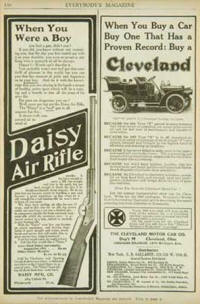| |
 |
|
 |
|

The Happy Daisy Boy |
|
 |
|
| |
 |
|
 |
|
In late December 1911 a letter from a Charles F.
Lefever of St. Louis found its way to the desk of
E.C. Hough. In it Mr. Lefever said he had designed
a pump gun. He laid out his credentials and said if
Daisy was interested someone could “…come to St.
Louis to see me, and I will show you the gun.” With
the flurry of end of year business a perfunctory
response was sent saying that if Daisy were
interested “…he would be contacted in the future.”
Back came a letter saying if Daisy wasn’t interested
others would be. Some years later Mr. Hough said
such a letter would have turned him off but because
the concept intrigued him he set out in early
February to visit St. Louis and meet Mr. Lefever.
Mr. Hough quickly realized that the gun design and
the man were unique and invited him to Plymouth to
which he agreed saying ”… for a few months to get
you started.”
A month later Lefever arrived in
Plymouth and remained a part of Daisy until his
retirement in February 1953. During the ensuing
years Lefever designed and engineered such Daisy
classics as the Model 25. That remarkable pump gun,
which was first produced in 1914, continued in
production for the next 64 years until it was
dropped from the line in 1979. At the time it was
discontinued more than 8,000,000 of the guns had
been produced and sold. Within two years of his
arrival he had also designed the first water pistol
and with the outbreak of World War I in August 1914,
the Model 40 Defender which was an instant and
overwhelming commercial success.
A cantankerous soul, Lefever quit
nearly once a year during the 41 years he “chose to
work for Daisy.”
The first handmade prototype of
Lefevre’s Model 25 pump gun is on display at the
Daisy Airgun Museum.
1880 ║ 1890 ║
1900 ║
1910 ║
1920
║ 1930 ║
1940 ║
The War Years
1950 ║
1960 ║
1970 ║
1980 ║
1990 ║
2000 ║
The Museum
|

